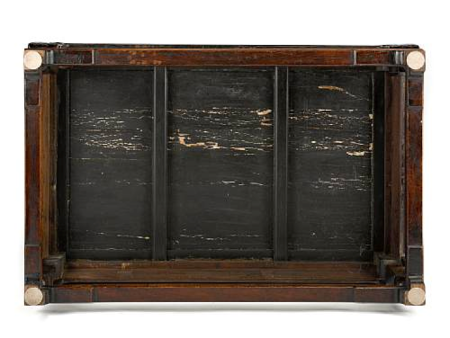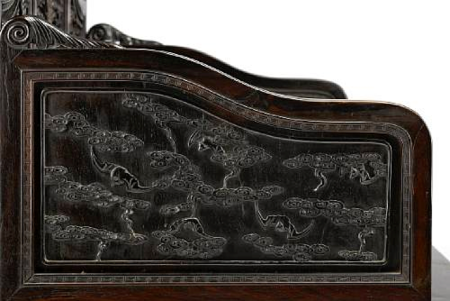An elaborately carved zitan and hongmu throne chair. 19th century
An elaborately carved zitan and hongmu throne chair. 19th century; Photo Bonhams
The three-part top rail set off with a leaf and scroll work edge framing a recessed central panel carved with clouds and a central bat above three elaborately carved panels featuring profiled dragons flanking a central five clawed dragon each below a specific trigram medallion set into a network of scrolling clouds, the lower sections captured with more clouds and trigrams above a caned hard seat, the exterior side panels elegantly rendered with bats and scattered clouds over a pierced waisted frame with cloud collar corner brackets carved into hipped cabriole legs resting on single balls and joined to a separately carved humpback stretcher frame. 40 3/8 x 40 1/2 x 29 1/4in (102.9 x 111 x 74cm); Sold for US$1,022,500
Property from the Estate of Elinor Majors Carlisle, San Francisco
Note: The three unbroken or yang lines within the circle carved into the top panel forms a 'trigram' (gua) described in the Yijing (or 'Book of Changes') as Qian or heaven-- like the dragons carved around it, it is the purely yang, or active element of the universe. In the small panel carved directly beneath, there is a trigram consisting of three broken or yin lines: it is the the earthly kun, female or passive element of the universe. As described in the Yijing, together these two elements of yin and yang, and their various permutations, combine to form the cosmos of heaven and earth. Here, 'read' from the top of the throne to the bottom, the six total lines combine to form a 'hexagram,' in this case: tai. As James Legge's translation of the Yijing would have it, tai augurs 'the little gone and the great come, there will be progress and great success.' (I Ching: Book of Changes, trans. Legge, University Books, New York, 1979). This is the hexagram typically associated with the first month of the lunar year, and the auspicious new beginnings therein; it is also the astrological concept that inspired the re-occurring Qing decorative motif of three peacefully grazing or resting sheep (or 'yang' in Chinese) often found rendered in jades, porcelain, or bronze: san yang kai tai, or 'three yangs start out a tai.' (A more complete explanation can be found in Hidden Meanings in Chinese Art, Tse-Bartholomew, San Francisco 2006) As the central element in the present lot, it is certainly a fittingly propitious way for a Son of Heaven and his five-clawed dragons to anchor the cosmos and a throne.
The cosmological symbolism can be continued further: there are two opposing trigrams carved into each of the arms of the chair: one trigram with two yin lines separated by a yang line (kan) and one with two yang lines separated by a yin line (li.) They are respectively the trigrams associated with water and fire, and more importantly, the twin poles of the universe in miniature found within the human body, one's jing or essence centered in the kidneys and one's shen or spirit centered in the heart. Daoist neidan ('inner alchemy') practices were an attempt to merge the two and become a deity; an imperial fixation since Qin Shihuang (see the Eastern Han dynasty text Zhou Yi Can Tong Qi as explicated by Liu Guoliang, Taipei, Sanmin Shuju 1999, or Yuan Kangjiu's research into the influence of Laozi on the Five Dynasties neidan techniques attributed to Lu Dongbin and Zhongli Quan in Zhong Lu Neidan Daode Guan Yanjiu, Beijing, Zongjiao Wenhua Chuban She 2005).
However, the configuration of the remaining trigrams in the present lot resist easy interpretation. Despite the fact that there are eight total trigrams and eight panels, there are actually three trigrams missing - dui, zhen, and xun - with li kun and gen (from top to bottom, one yang line and two yin) auguring stability; see Legge plate III figure 1) duplicated in the remaining four panels. The simplest explanation is that the panels were all pieced together from different pieces of furniture or were crafted for or by people without a strong understanding of traditional Chinese cosmology. However, given their influence on fengshui, traditional Chinese medicine and Confucian theories of power and ethics, it is also possible that the odd placement of these trigrams was for a specific but esoteric reason now lost to history.
Bonhams. Fine Asian Works of Art, 20 Dec 2011, California, San Francisco www.bonhams.com

/https%3A%2F%2Fprofilepics.canalblog.com%2Fprofilepics%2F1%2F0%2F100183.jpg)
/https%3A%2F%2Fstorage.canalblog.com%2F03%2F02%2F119589%2F96711876_o.jpg)
/https%3A%2F%2Fstorage.canalblog.com%2F11%2F31%2F119589%2F94773502_o.jpg)
/https%3A%2F%2Fstorage.canalblog.com%2F20%2F83%2F119589%2F94772815_o.jpg)
/https%3A%2F%2Fstorage.canalblog.com%2F26%2F72%2F119589%2F75604929_o.jpg)
/https%3A%2F%2Fstorage.canalblog.com%2F59%2F60%2F119589%2F26458628_o.jpg)








/http%3A%2F%2Fstorage.canalblog.com%2F00%2F00%2F119589%2F129758935_o.jpg)
/http%3A%2F%2Fstorage.canalblog.com%2F29%2F28%2F119589%2F129637299_o.jpg)
/http%3A%2F%2Fstorage.canalblog.com%2F88%2F37%2F119589%2F129631480_o.jpg)
/http%3A%2F%2Fstorage.canalblog.com%2F77%2F79%2F119589%2F129631259_o.jpg)